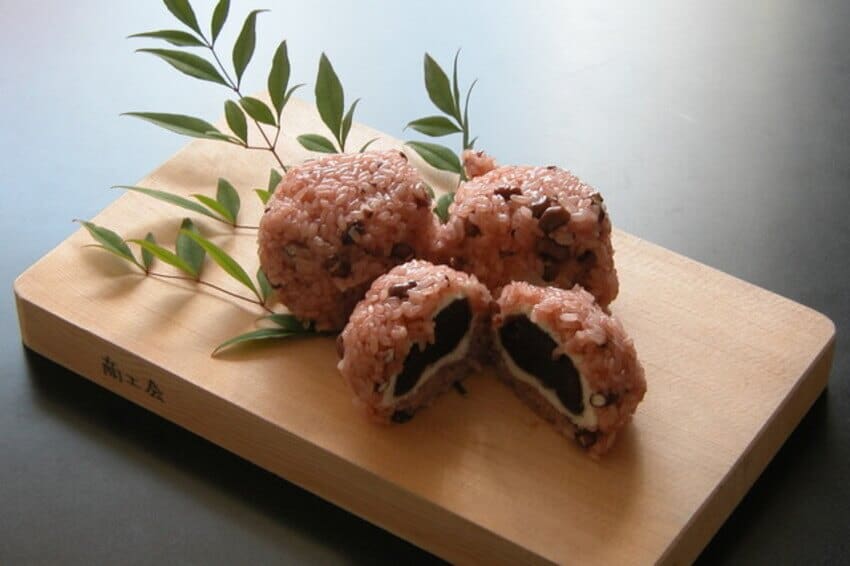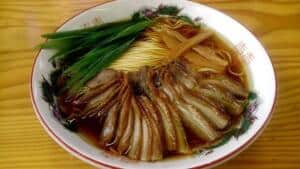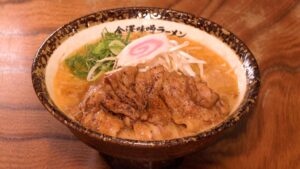Let’s talk about the rich and flavorful history of Nagahama, a city steeped in its unique tastes. Nagahama Ramen, from the 1960s, delivers a special soy sauce-infused noodle soup, unlike regular ramen. Dive into the story and whip up a quick recipe of this delectable food that began in Nagahama Fish Market. Let’s also spot good places to try it and tackle some quick facts about this delicious dish from Fukuoka.
What is Nagahama Ramen?
Nagahama Ramen stands out as a quick and budget-friendly ramen, specifically crafted for the hardworking folks in the bustling Nagahama Market. To meet the need for speed, they introduced thin noodles that cook up fast. It’s also affordable! An intriguing twist is the serving of “ramen soup” at your table, compensating for any dilution caused by the addition of kaedama.
Kaedama means an extra serving of ramen noodles.
This unique approach ensures a satisfying and affordable ramen experience that echoes the lively spirit of Nagahama Fish Market’s culture.
Nagahama Ramen stands out with its light broth and slender noodles, gaining popularity for its robust flavors. You can also customize your Nagahama Ramen similar to Hakata Ramen by specifying the fat content and noodle firmness. Then, choose from options like yawa, kata, raw, or kakiage for noodle firmness, and select nashi or beta for the amount of fat. This unique customization adds a personal touch to your Nagahama Ramen experience, allowing you to tailor it to your taste preferences.
What is the difference between Nagahama Ramen and Hakata Ramen?

Hakata Ramen, from Fukuoka, has a creamy pork bone broth, giving it a velvety texture. The thick noodles go perfectly with the hearty broth, making each bite savory. In contrast, Nagahama Ramen has a unique approach with its soy-infused light broth and thin noodles. The balance of flavors in Nagahama Ramen is lighter and more nuanced compared to the richness of Hakata Ramen.
In addition to variations in broth and noodles, both Hakata Ramen and Nagahama Ramen let you personalize your bowl. Hakata Ramen fans can adjust noodle firmness and broth richness for a customized culinary experience. Similarly, Nagahama Ramen aficionados can tailor their bowls by selecting noodle firmness and adjusting the fat content in the broth. These customizable features add a distinct touch to each bowl, allowing ramen enthusiasts to create their ideal flavor. Whether you prefer Hakata’s creamy richness or Nagahama’s subtle simplicity, exploring these regional specialties ensures a flavorful journey through diverse Japanese ramen types.
The Origin
Ganso Nagahamaya was the restaurant that created and offered Nagahama Ramen. Initiated by an ardent ramen enthusiast, they aimed to widely share the delectable essence of ramen. He also aspired to transform the local dish into a globally recognized phenomenon.
Through experimentation with a variety of ingredients and seasonings, the founder meticulously crafted the recipes. Because of its harmonious flavors, the ramen swiftly became a local sensation.
In its founding period, the original Nagahamaya garnered attention from local media, featuring in numerous interviews and articles. Consequently, the restaurant’s name and its unique taste gained widespread recognition, turning the original Nagahamaya ramen into a sudden local specialty.
Driven by a dream to spread joy and novel cultural experiences, the founder encountered numerous obstacles when establishing the original Nagahamaya restaurant. However, despite these challenges, this passionate endeavor marked the inaugural chapter in Nagahama Ramen’s history. Eventually, it endeared the restaurant to many and unfolded fresh possibilities.

Nagahama Ramen FAQ
- Is Nagahama Ramen the same with Hakata Ramen?
While it is often associated with Hakata noodles, some diehard ramen fans argue that there are distinct variances between them.
- What is the kind of soup based used?
Nagahama Ramen uses Tonkotsu or pork bone soup.
Nagahama Ramen Recipe
Making this Fukuoka dish is a fusion of both history and culinary tradition. Of course, the main star of the dish is its broth.
Ingredients
| Good for 1-2 persons | |
| pork skull | 1 whole (skinned) |
| backfat | 200 g |
| water | 5L or more |
| thin straight noodles | 200 g |
| char siu | 1-2 slices |
| wood ear mushrooms (optional) | ample amount |
| green onions | ample amount |
Preparing the broth

To begin with, parboil the pig skull in a deep pan. After two hours, turn off the heat and let it sit for a while.
Then, remove any scum on the pork skull using clean water. Since it’s already parboiled for two hours, the pork skull becomes oily and sticky.
After that, boil the pork skull and add 200 grams of backfat to promote emulsification. Use high heat until the water is reduced to four liters (4L). This time, the soup should be creamy.
When the soup reaches the creamy visual, bring it back to heat. However, boil it using medium to low heat this time. Make sure to leave the lid slightly open while simmering.
Of course, some meat may stick to the bottom of the pan while in the process of boiling. Scrape off the bottom of the pan to ensure no raw meat is left.
As soon as the soup becomes cloudy and thick, turn off the heat. Adding salt is also an option to make the broth even more flavorful. In addition, it should smell like sweet pork bones by this time.
How to make Nagahama Ramen?

When the broth is ready, start preparing the noodles. Choose the thin and straight noodles. Put a small amount of noodles in the bowl similar to Hakata Ramen.
Then, add the hot tonkotsu broth filling up to about three-quarters of the bowl.
After that, place a piece of char siu on top to add more flavor to its already rich pork taste. Another ingredient that brings more flavor is wood ear mushrooms. Cut into thin slices and toss it beside the char siu.
Lastly, sprinkle with chopped green onions or scallion and serve.
Tips
- Adding sesame oil and ground sesame is optional.
- To make it spicy, some locals also add chili oil or even Korean chili paste.
Where to eat Nagahama Ramen?
Nagahama Number One (ナンバーワン 赤坂屋台店)

It’s a famous restaurant that is one of the landmarks in the Nagahama food district. As a matter of fact, the lines here are always long and they have a few branches too. It’s also where you can enjoy the authentic taste of Daisho Nagahama Yatai Ramen.
Since there are only a few seats inside the store, it’s really difficult to get in. However, the service is quick and many people just eat and leave right away.
Nagahama Mangetsu (長浜 満月)

Aside from the Nagahama no 1 ramen, this shop is also known for its skewers and small gyoza. Also, frequent visitors usually pair their beer with this selection including stir-fried wagyu beef, meatballs, and cheese bacon.
The restaurant personnel are also engaging to converse with, and they gladly join patrons for drinks, fostering a convivial ambiance.
Waka Taishō (若大将)

Just a brief walk from Nagahama Mangetsu, you’ll discover Waka Taishō. Specializing in tempura, they offer mouthwatering bites at wallet-friendly prices. They also have vegetable tempura that’s a crispy delight featuring eggplant, sweet potato, carrot, shito pepper, and pumpkin. On the other hand, their seafood tempura, skewers, and oden give a feeling of coming home.
Meanwhile, the Nagahama Yatai Ramen features the chef’s signature egg noodles and costs only 500 yen. Of course, the curliness of their noodles is what sets them apart from other restaurants. In addition to that, the shop has a meticulous custom ordering process. It’s a place where you’ll forget you’re at a food stall and just enjoy the real flavors of the dishes.
Takeaway
Daisho Nagahama Yata Ramen is often compared to Tonkotsu Ramen. That’s because the first one uses an almost identical soup base. Aside from that, some people also think it’s the same as Hakata Ramen. However, Nagahama Ramen has its own characteristics and history that ramen enthusiasts know.
Nagahama Ramen is known for being quick and affordable, perfect for busy people at Nagahama Market. They use thin noodles that cook quickly to save time. Plus, it’s budget-friendly!
If you’re already in Fukuoka, you should try the Nagahama Yatai Ramen. You can also taste other delectable dishes in the area like Kurume Ramen, Hakata Torimon, and Kashiwa Udon.
















Comments